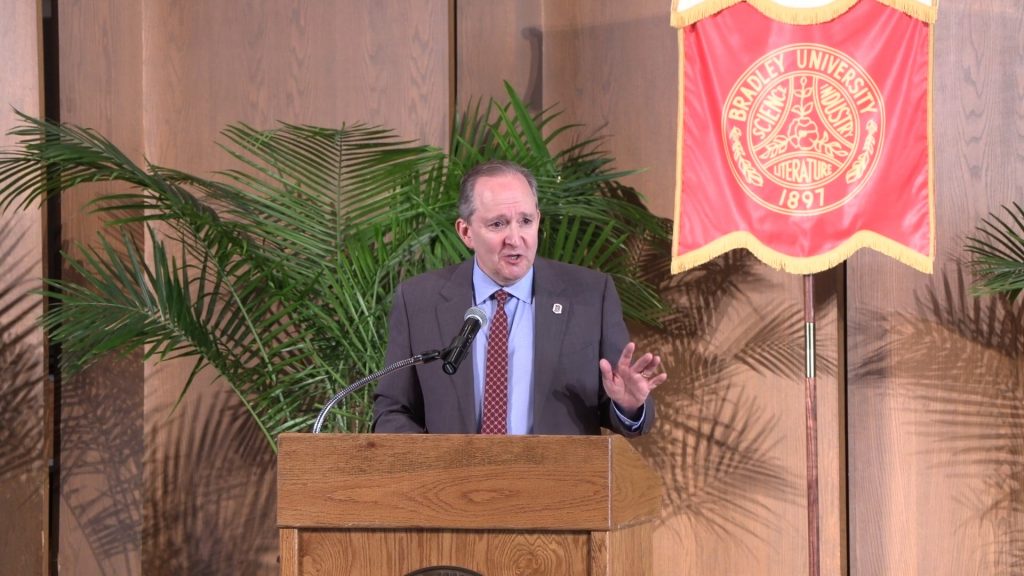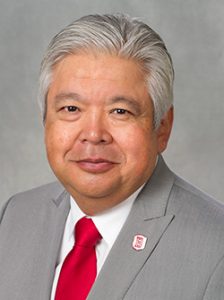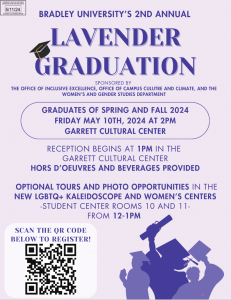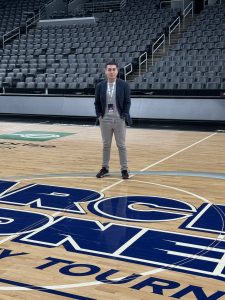
Bradley President Stephen Standifird gave his second State of the University address on Oct. 3 in the Dingeldine Music Center. In giving an overview of Bradley’s status in various areas, Standifird spoke about the current status of the university’s finance, enrollment and national ranking, also discussing changes seen in the last year and a subsequent series of action items for ongoing initiatives.
CURRENT STATUSES
Finance
In regards to Bradley’s financial standing, Standifird shared that the university closed the 2021-22 academic year with a positive operating income of $5.8 million, a margin that he said was constituted by HEERF funds from pandemic emergency relief and accounting for post-retirement funds.
Standifird also stated that for the current academic year, Bradley’s Board of Trustees was given two budget proposals — one for a balanced budget that would have required foregoing investments that he described as critical for long-term success, and a budget that included a $3 million deficit. The board reportedly approved the latter budget, and Standifird assured that this budget would allow for current investments to increase the university’s financial stability in the future.
These potential deficit dollars will reportedly go to an across-the-board 2% raise effective Jan. 1 of next year, a number that Standifird hopes will rise along with the university’s fiscal strength. The president also reiterated that the deficit would be sustainable in the short-term, and would allow a balanced budget to be attainable down the road.
“From a financial perspective, we’re doing okay with the opportunities to get stronger, but we’re actually in pretty good shape,” Standifird said.
Enrollment
In detailing Bradley’s current enrollment status, Standifird emphasized the ongoing effect of the pandemic on the data, at one point referring to it as “a level of decreased demand previously unseen in higher education.”
According to the president, Bradley saw a 0.5% decline in first-year student enrollments in the last year, slightly better than the nationwide average of 1.5% among private colleges. This translates to fall 2022 seeing an incoming undergraduate class of 1,037 students, down slightly from 1,042 new students in the fall of 2021. However, an approximate 31% increase in graduate student numbers — 295 in the fall semester of 2021 to 386 in the fall semester of 2022 — and a two-year increase in international student numbers was also highlighted.
The collective outcome of 5,552 current students (4,143 undergraduate, 1,409 graduate) led Standifird to the same conclusion as Bradley’s fiscal numbers.
“Similar to our financial position, from an enrollment perspective, we’re doing okay,” Standifird said.
National Ranking & Competition
While Princeton Review recognized Bradley as one of America’s best institutions for undergraduate students, Standifird spoke of seeing “significant” change in Bradley’s national media standing in this year’s U.S. News and World Report rankings.
This year marks the first time Bradley has been classified as a national professional doctoral granting institution, due to the amount of doctoral degrees awarded in health science. The university ranked 166th nationally, which is above schools such as Belmont, Valparaiso and Illinois State, in a near-tie with schools including Xavier, Saint John’s and Mercer, and below schools like Drake, Loyola and Creighton. Standifird noted being “particularly excited” about Bradley’s standing relative to Illinois State.
Standifird was in good spirits about Bradley’s ranking, as it would enable the university to compete on a national scale.
“It’s a lot easier to stand out in the smaller pond of Midwest regional schools,” Standifird said. “Our opportunity moving forward, our absolute opportunity moving forward, is to create a level of distinction that allows us to stand out at the national level. And this is exactly what we’re doing with our strategy.”
Standifird highlighted this as important in the face of the hyper-competitive market that exists among higher education in regards to undergraduate students, but also stated that he believed the challenges set to arise would create more opportunity to respond to students.
“We are competing at the highest level,” Standifird said. “We compete at this high level by remaining laser-like-focused on our strategy and responding to the needs and interests of today’s students.”
The president also cited an October 2020 study that found that higher education enrollment rates have stagnated since the 2008 recession as more reason to prioritize students.
“For over a century, higher education didn’t need to be responsive,” Standifird said. “We assumed if we built it, they will come. We did, and they did. But those days are over. The future belongs to those universities that are genuinely responsive to the needs and interests of today’s students. That’s what our strategy is all about. And that’s why, despite the challenging environment in which we operate, I’m optimistic about the future.”
ACTION ITEMS
On the subject of highlights of Bradley’s accomplishments in the previous year, Standifird presented a strategy created using data collected from over 600 prospective students in America being surveyed, which was then validated with 10 Bradley focus groups composed of undergraduate, graduate and online students. From this research, a series of 11 action items revolving around various initiatives. While some action items are still in progress or have been put on pause to allocate more resources to others, here is a rundown of the most productive action items thus far.
- Identify and onboard the inaugural Vice President for Diversity, Equity & Inclusion: Dr. Warren Anderson joined Bradley in this VP role earlier in January. On top of his establishment of the Office of Inclusive Excellence and the Office of Campus Culture and Climate, further social initiatives will include an open-forum campus climate survey across all Bradley personnel in the spring, a bias incident reporting and response protocol and Presidential Commissions in areas like race and ethnicity, gender identity and orientation, access and ability and socioeconomic status.
- Establish the Center for Interdisciplinary Studies: This long-term plan has seen current results in a comprehensive draft center plan led by professor Derek Montgomery and the launch of six pilot programs focused on first-year experience and faculty-mentored undergraduate research.
- Increase financial strength: Continuing off the momentum of a major debt restructuring this last year, which Standifird described as “one of the most significant actions we could have taken to assure the long-term viability of the university,” Bradley has shifted to an incentive-based budget that reportedly includes a deferred maintenance plan to avoid disrepair within facilities due to underinvestment. The president reported on changes around campus including significant renovation of University Hall occurring over the summer.
- Modernize technology processes: In the last year, Bradley has transitioned 108 technology systems onto more sustainable platforms and implemented employee multi-factor authorization for increased security.
- Expand student success resources: Bradley currently has a six-year undergraduate graduation rate of 77.1%, which is better than the reported peer average of 75.5% but still entails the failure to graduate for almost 23% of students, Standifird described this action item as a cross between “academic support, student support, student access and counseling.” This action item will include the expansion of B-Prep, a week-long program for students who did not academically qualify for their preferred major, the use of the Navigate app, which functions as a hub for student resources, and a “reconceptualizing” of the Academic Success Center, all of which will move towards a projected optimal six-year graduation rate of 90%.
- Identify and develop “flexible academic pathways”: With assistance from the University Senate modifying the academic calendar and reducing the credit hours needed to complete an undergraduate degree, Bradley will implement further steps for the purpose of increasing academic flexibility. Standifird said it will help students complete their degrees by identifying new areas of interest. These steps include the launch of new online degrees in several areas of nursing, computer science and not-for-profit leadership, as well as a collaboration with Illinois Wesleyan University. This collaboration will allow Bradley students interested in studying Japanese to do so through courses at Illinois Wesleyan, while Illinois Wesleyan students can take Bradley courses for Chinese and Arabic.
- Develop a systematic approach to engaging community partners: According to Standifird, Bradley has developed a formal research partnership with OSF and has collaborated with Illinois Community College and Eureka College to acquire a $14 million grant for the region, of which $2 million will go directly to Bradley. The university is also reportedly in discussions regarding the creation of a regional education healthcare consortium and a Washington, D.C.-based Congressional Internship Program specific to Bradley.
LOOKING AHEAD
Looking towards the future, while acknowledging Bradley’s highly competitive environment and the campus community having to work through pandemic-related challenges such as general fatigue and reduced resources, Standifird spoke of feeling positive as a result of the strategies that are currently in place.
“I’m optimistic because I can feel the progress,” Standifird said. “And I know I absolutely know the impact it’s going to have on us long term. We are shaping the future of higher education, and I cannot thank you enough for doing so.”
Staff
Standifird disclosed plans for a comprehensive staff salary initiative and the creation of a staff council. The staff salary initiative will include an assessment of hourly positions, as well as compensation structures, and will be enacted throughout the remainder of this calendar year, with resultant changes being implemented over the next few years. The staff council acts as a platform to allow Bradley staff to have a say in the university’s future. The president vowed that more information on both would be shared in coming months.
Marketing & Communications
Standifird stated that advancement, marketing and communications would be essential areas for the university, as the search for a new Vice President of Advancement is underway. The committee for this search is co-chaired by Standifird and also includes four of Bradley’s Board of Trustees. The applicant deadline for this position was on Oct. 4, the day of the address, with the interviewing process slated to occur between this month and November and an offer in December and a VP selection announcement in January.
Identifying a new Associate Vice President of Marketing & Communications is also on Bradley’s itinerary, which Standifird said will entail a deep dive into how Bradley recruits students. To this end, he drew on the image of a “recruiting funnel,” with student application and admittance at the top and student yield rate (percentage of admitted students that enroll) at the bottom. Standifird admitted that Bradley’s yield rate lagged behind fellow schools.
“Our opportunity moving forward is to become much more active in how we recruit our students after they’ve applied and been accepted,” Standifird said.
CLOSING
Standifird closed by connecting the value he saw in Bradley’s current strategies to the university’s 125th anniversary, and stating that the strategies are a continuation of Lydia Moss Bradley’s mission to cater to the needs and interests of students.
“I stand here today and confidently say that if we stay the course and remain focused on genuinely responding to the needs and interest of today’s students, we will take Bradley University to new heights and lay the foundation for the next 125 years of success,” Standifird said.





[…] source […]